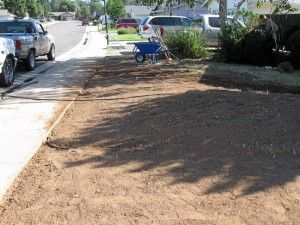No parental units were nagged, nudged or coerced for the purposes of this column.
When I think of visits to my mom’s house, her beautiful garden is central in my mental image.
A comfortable sitting area is surrounded by potted plants. She started with bare, rotten Redding dirt – so hard she hired someone with a jack hammer to dig holes for trees. For years she brought in truckloads of mulch and good topsoil. Over time, things grew more beautiful.
The fact that she hasn’t formed a habit of composting is strange to me. However, my Mother is perfect in most other ways.
Her front yard, by contrast, is a pass-through area. My sister and I dump our bags on the front porch while we wait for Mom to answer the pounding on the door.
When Mom mentioned she was tearing out her front lawn, I had to strain to remember she had grass at all.
I did, however, recall her high praise for the nice boy next door who did her yard maintenance.
The boy’s father taught him to write up an invoice and to send my mother a bill. This kept the accounting straight.
When the boy went to summer sports camp, his father taught him to find a replacement for my mother’s weekly mow, which often meant the younger brother.
My mother’s lawn provided an educational experience for the boys next door, but other than that the turf served little use at all.
The boys went away to college and drought hit California.
Mom decided to be done with the front lawn once and for all.
I was shocked to hear she formerly had 24-by-34-feet of lawn. I wish I had at least kicked off my shoes and frolicked at least once in the past 18 years.
There is no lawn replacement incentive program in Redding. (For information on the program in Chico, https://calwater-turf.droplet.us).
Her project cost $1,500, start-to-finish.
Workers tore out all of the lawn, moving the material to her back yard to create a berm. It’s been a while, but in years when a very hard rain occurs, Mom has some flooding issues in the “back 40.”
The crape myrtle is the main feature in the front yard, and has done really well over the years. Bonus that these trees are drought and heat tolerant.
Mom planted an additional crape myrtle tree, plus two miniature crape myrtles. She also chose some new lavender and rosemary plants.
“I’m still looking for some white no-water grasses,” Mom said. She knows she saw some in a magazine article, but will need to track them down.
Also, she left some shrubbery at the perimeter of her yard. This will be watered with a new drip irrigation system. If the existing plants don’t like the new watering schedule, she’ll let them die with absolutely no remorse.
The sprinklers have been capped off and smooth river and bark mulch now replace the lawn area.
She said she already saw a water saving from her first bill, and will check once she goes a full month without the front turf.
Another neighbor has taken out half of his front lawn, Mom noted. Another woman on her street came by to chat about the rocks and bark.
Drought gardens are not particularly beautiful when they are brand new. However, the previous few weeks this column featured water-saving gardens with more time to mature. Mom’s choice to leave some of her plants in place, for now, may help during the transition.
With the rate of lawn conversions, I could probably write about them for the rest of the summer. If you have a great yard to share, drop me a line at hhacking@chicoer.com. Other contacts, @HeatherHacking on Twitter and Facebook.


